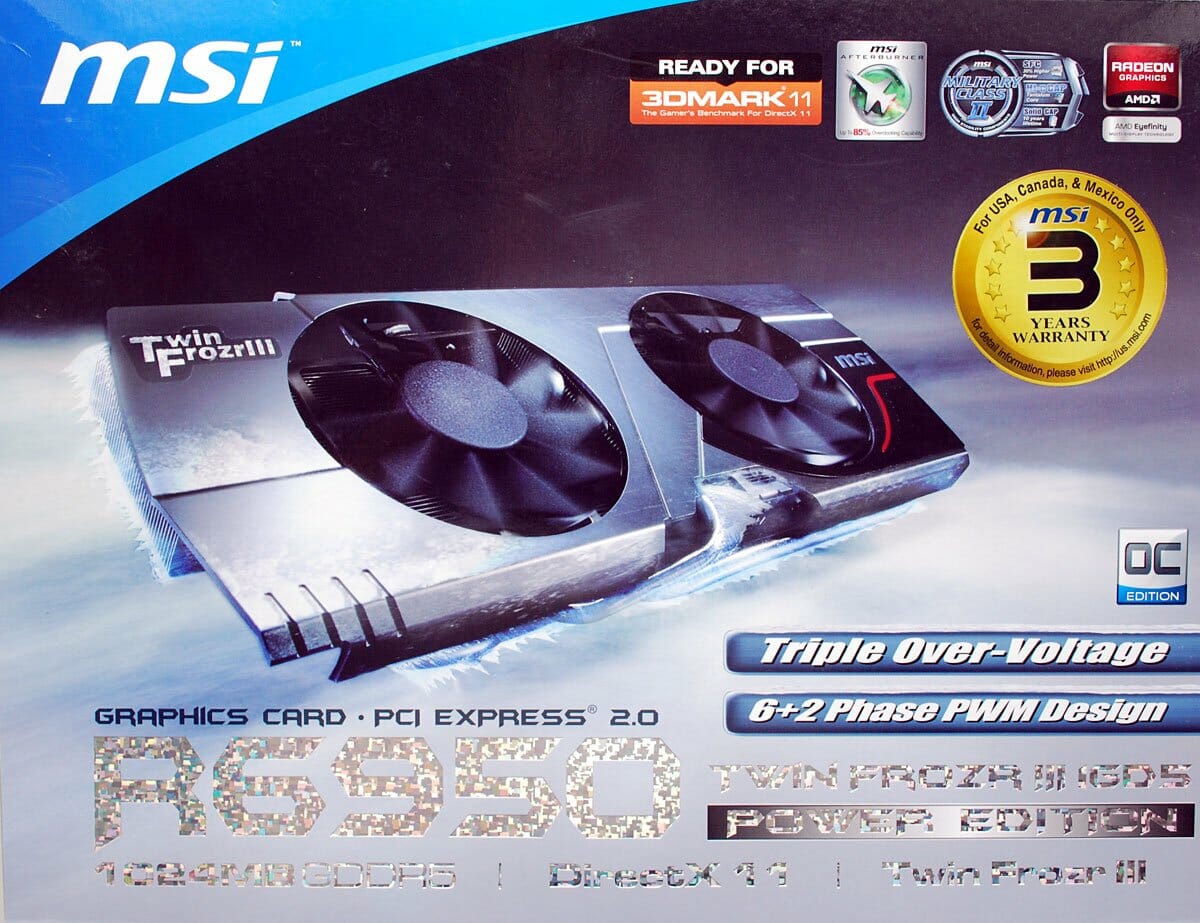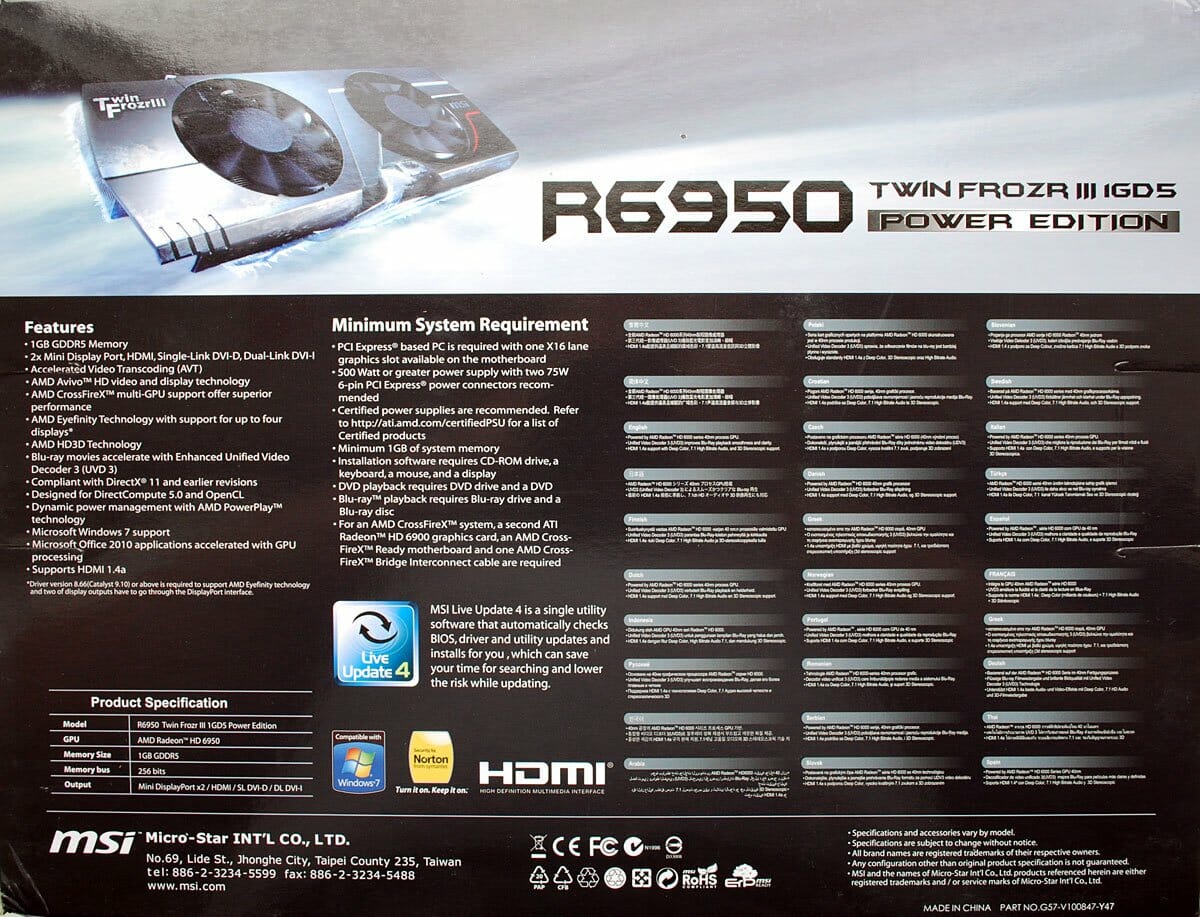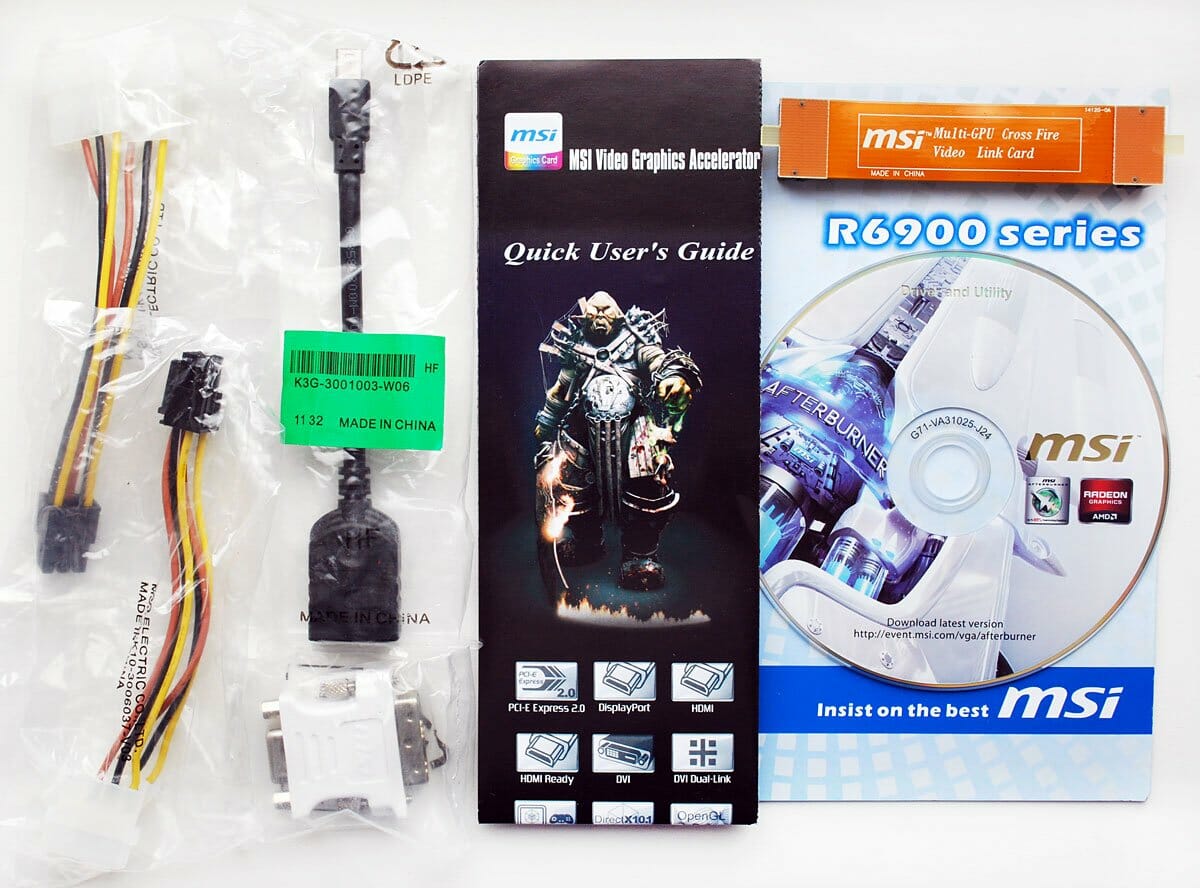MSI R6950 Twin Frozr III 1 GD5 Power Edition OC Graphics Card

This review is dedicated to the newest graphics accelerator that combines all the advantages if a high-end product with a very appealing price for its class.
The latest news from the computer graphics realm suggest that we are not going to see new GPUs this year as AMD and Nvidia are both expected to introduce their next top-end solutions in Q1 2012. It means that if you are shopping for a fast graphics card right now, you have to choose from the last-year products based on the Cayman and Barts or the GF110 and GF114 processors depending on what GPU brand you prefer. We, on our part, keep on testing and reviewing the most original and exciting of such products. Today we’ve got a graphics card from MSI which seems to combine the best in terms of the GPU, PCB and cooling. Closer Look at MSI R6950 Twin Frozr III 1GD5 Power Edition/OC
Packaging and Accessories
The R6950 Twin Frozr III 1GD5 Power Edition/OC comes in a large eye-catching box with shimmering text and a picture of its frost-covered cooler on the face side.


You can learn right away that the card comes with a 3-year warranty, has an 8-phase power system, is ready for 3DMark 2011, etc. Its detailed specs and system requirements can be found on the back of the box. If you feel like getting even more information, you can unfold the top of the box to view detailed descriptions of each of the product’s components.
The product’s accessories are exhaustive: two power cables, a mini-DisplayPort->DisplayPort adapter, DVI-I->analog adapter, CrossFireX bridge, CD with drivers and utilities, installation guide and an ad booklet.

The only thing that seems to be missing here is a video game or a coupon for downloading one for free. The R6950 Twin Frozr III 1GD5 Power Edition/OC is manufactured in China and costs about $259 in retail. Its warranty period is 3 years.
PCB Design
Its face side is covered with a dual-slot Twin Frozr III cooler and its aluminum casing. By the way, the casing makes the card longer by an extra 17 millimeters.
The casing might have been shorter, which would make the card compatible with more system cases (its PCB is only 242 millimeters long whereas the cooler makes it as long as 270 millimeters). On the other hand, we have to acknowledge that it looks stylish.
The R6950 Twin Frozr III 1GD5 Power Edition/OC is equipped with two dual-link DVI-I outputs, one HDMI connector and two mini-DisplayPorts.
Notwithstanding the generous selection of connectors, there is enough space left on the card’s mounting bracket for a vent grid. As we found out during our noise level tests, some of the hot air is indeed exhausted through that grid, but most of it is thrown out in the opposite direction.
The graphics card is equipped with two interface connectors for CrossFireX configurations and has two 6-pin power connectors.According to AMD’s specs, the Radeon HD 6950 has a peak power draw of 200 watts in 3D applications (about 140 watts under typical gaming load). However, the MSI card may differ in this respect as it has a custom PCB, increased frequencies and less of onboard memory.
MSI classifies the card’s PCB as “Military Class II”, meaning high-quality and durable components, although it looks like a regular second-revision Radeon HD 6950 PCB.
We’ve got an 8-phase power circuit here: six phases for the GPU and two for the memory chips. The uPI Semiconductor uP6218 controller supports the Triple Over-Voltage feature, which means you can use MSI Afterburner to tweak the card’s voltages.
There is a small switch near the power connectors in the top part of the PCB. It selects the cooler’s operation mode: Performance or Silence. This in fact selects one of the two BIOS versions. The switch is set at Performance by default.
Manufactured in Taiwan in late January 2011, the Cayman GPU has an open die with a size of 289 sq.It has a standard Radeon HD 6950 configuration with 1408 shader processors, 88 texture-mapping units and 32 raster back-ends. The GPU frequency is pre-overclocked by 6.3% from 800 to 850 MHz at a voltage of 1.1 volts. The frequency and voltage are reduced to 250 MHz and 0.9 volts in 2D applications.
As opposed to most Radeon HD 6950s, the MSI version comes with 1 rather than 2 gigabytes of GDDR5 memory. The eight FCFBGA-packaged chips located on the face side of the PCB are manufactured by Elpida and marked as W1032BABG-50-F.
This 5ns memory is rated for 5000 MHz but the MSI card clocks it at 5200 MHz, which is 200 MHz higher than the memory frequency of the reference Radeon HD 6950. The clock rate is lowered to 600 MHz in 2D applications. The memory bus is 256 bits wide.
Overclocking Potential
Our R6950 Twin Frozr III 1GD5 Power Edition/OC could be overclocked to a GPU frequency of 940 MHz, which is good enough for a junior Cayman. The highest memory frequency we could achieve was 5680 MHz.
When overclocked, the card’s GPU got only 1°C hotter but the cooler’s fans rotated at 3300 RPM (Performance mode) rather than at 3060 RPM.
Testbed Configuration and Testing Methodology
All graphics cards were benchmarked in a closed system case with the following configuration:
- Mainboard: Gigabyte GA-X58A-OC (Intel X58 Express, LGA 1366, BIOS F5c from 09/06/2011);
- CPU: Intel Core i7-980X Extreme Edition, 3.33 GHz, 1.225 V, 6 x 256 KB L2, 12 MB L3 (Gulftown, B1);
- CPU cooler: Thermalright Archon (Thermalright TY-140 fans at 600-1260 RPM);
- Thermal interface: ARCTIC MX-4;
- System memory: DDR3 3 x 2GB OCZ Platinum Low-Voltage Triple Channel (Spec: 1600 MHz / 7-7-7-24 / 1.65 V);
- Graphics cards:
- MSI R6950 Twin Frozr III 1GD5 Power Edition/OC 1 GB / 256 bit, 850/5200 MHz and 940/5680 MHz;
- Sapphire Radeon HD 6950 Toxic Edition 2 GB / 256 bit, 850/5200 MHz, was tested as Radeon HD 6970 at 880/550 MHz and 940/6000 MHz;
- System drive: RAID-0 of 2 x Kingston V-series SNV425S2128GB SSD (SATA-II, 128 GB, MLC, Toshiba TC58NCF618G3T controller);
- Drive for programs and games: Western Digital VelociRaptor (300GB, SATA-II, 10000 RPM, 16MB cache, NCQ) inside Scythe Quiet Drive 3.5” HDD silencer and cooler;
- Backup drive: Samsung Ecogreen F4 HD204UI (SATA-II, 2 TB, 5400 RPM, 32 MB, NCQ);
- System case: Antec Twelve Hundred (front panel: three Noiseblocker NB-Multiframe S-Series MF12-S2 fans at 1020 RPM; back panel: two Noiseblocker NB-BlackSilentPRO PL-1 fans at 1020 RPM; top panel: standard 200 mm fan at 400 RPM);
- Control and monitoring panel: Zalman ZM-MFC2
- Power supply: Xigmatek “No Rules Power” NRP-HC1501 1500 W (with a default 140 mm fan);
- Monitor: 30” Samsung 305T Plus.
For comparison purposes we also included the results of Sapphire Radeon HD 6950 2 GB Toxic Edition.
It was tested in three modes:
- As HD 6950 at 850/5200 MHz frequencies, which will show the performance difference between two identical graphics cards equipped with different amount of onboard video memory;
- As HD 6970 at the reference 880/5500 MHz frequencies, which will show how far the overclocked MSI card falls behind the reference Radeon HD 6970;
- As HD 6970 at maximum overclocked frequencies of 940/6000 MHz.
In order to lower the dependence of the graphics cards performance on the overall platform speed, I overclocked our 32 nm six-core CPU with the multiplier set at 25x and “Load-Line Calibration” (Level 2) enabled to 4.5 GHz. The processor Vcore was increased to 1.46875 V in the mainboard BIOS.
The 6 GB of system DDR3 memory worked at 1.44 GHz frequency with 7-7-7-16_1T timings and 1.5V voltage. Turbo Boost and Hyper-Threading technologies were disabled during our test session.
The test session started on October 2, 2011. All tests were performed in Microsoft Windows 7 Ultimate x64 SP1 with all critical updates as of that date and the following drivers:
- Intel Chipset Drivers 9.2.3.1020 WHQL from 10.04.2011 for the mainboard chipset;
- DirectX End-User Runtimes from November 30, 2010;
- AMD Catalyst 11.9 driver from 09.28.2011 for AMD based graphics cards.
The graphics cards were tested in two resolutions: the today’s most popular 1920×1080 and the maximum 2560×1600. The tests were performed in two image quality modes: “High Quality+AF16x” – maximum texturing quality with enabled 16x anisotropic filtering and “High Quality+ AF16x+MSAA4(8)x” with enabled 16x anisotropic filtering and full screen 4x anti-aliasing (MSAA) or 8x if the average framerate was high enough for comfortable gaming experience. We enabled anisotropic filtering and full-screen anti-aliasing from the game settings or configuration files. If the corresponding options were missing, we changed these settings in the Control Panels of Catalyst and GeForce drivers. There were no other changes in the driver settings.
The list of games and applications used in this test session includes two popular semi-synthetic benchmarking suites, one technical demo and 15 games of various genres:
- 3DMark Vantage (DirectX 10) – version 1.0.2.1, Performance and Extreme profiles (only basic tests);
- 3DMark 2011 (DirectX 11) – version 1.0.1.0, Performance and Extreme profiles;
- Unigine Heaven Demo (DirectX 11) – version 2.5, maximum graphics quality settings, tessellation at “extreme”, AF16x, 1920×1080 resolution with MSAA 4x;
- BattleForge: Lost Souls (DirectX 11) – version 1.2 (08.18.2011), maximum image quality settings, shadows enabled, SSAO technology enabled, two runs of the built-in benchmark;
- S.T.A.L.K.E.R.: Call of Pripyat (DirectX 11) – version 1.6.02, Enhanced Dynamic DX11 Lighting profile with all parameters manually set at their maximums, we used our custom cop03 demo on the Backwater map;
- Left 4 Dead 2 (DirectX 9) – version 2.0.8.8, maximum graphics quality settings, d81 demo (two runs) on “Gold Stream (Beta)” map of the “Alpine Greek” level;
- Metro 2033: The Last Refuge (DirectX 10/11) – version 1.2, maximum graphics quality settings, official benchmark, “High” image quality settings; tesselation, DOF and MSAA4x disabled; AAA aliasing enabled, two consecutive runs of the “Frontline” scene;
- Just Cause 2 (DirectX 11) – version 1.0.0.2, maximum quality settings, Background Blur and GPU Water Simulation enabled, two consecutive runs of the “Dark Tower” demo;
- Aliens vs. Predator (2010) (DirectX 11) – Texture Quality “Very High”, Shadow Quality “High”, SSAO On, two test runs in each resolution;
- Lost Planet 2 (DirectX 11) – version 1.0, maximum graphics quality settings, motion blur enabled, performance test “B” (average in all three scenes);
- StarCraft 2: Wings of Liberty (DirectX 11) – version 1.0, all image quality settings at “Ultra”, Physics “Ultra”, reflections On, two 2-minute runs of our own jt1 demo;
- Sid Meier’s Civilization V (DirectX 11) – version 1.0.1.217, maximum graphics quality settings, two runs of the “diplomatic” benchmark including five heaviest scenes;
- Tom Clancy’s H.A.W.X. 2 (DirectX 11) – version 1.04, maximum graphics quality settings, shadows On, tessellation Off (not available on Radeon), two runs of the test scene;
- Crysis 2 (DirectX 11) – version 1.9, Adrenaline Crysis 2 Benchmark Tool v1.0.1.12 beta, “Ultra High” graphics quality profile, High-Definition textures enabled, two runs of the demo in “Times Square” scene;
- Total War: Shogun 2 (DirectX 11) – version 2.0, built in benchmark (Sekigahara battle) at maximum graphics quality settings;
- DiRT 3 (DirectX 11) – version 1.1, built-in benchmark at maximum graphics quality settings on the “Aspen” track;
- World of Planes (DirectX 9) – alpha-version (from 08.19.2011), maximum image quality settings, one test run;
- Hard Reset Demo (DirectX 9) – benchmark built into the demo version with Ultra image quality settings, one test run.
If the game allowed recording the minimal fps readings, they were also added to the charts. We ran each game test or benchmark twice and took the best result for the diagrams, but only if the difference between them didn’t exceed 1%. If it did exceed 1%, we ran the tests at least one more time to achieve repeatability of results.
Performance
The diagrams show that the MSI R6950 Twin Frozr III Power Edition/OC is roughly equal to the Sapphire Radeon HD 6950 Toxic Edition. There is almost no difference between Radeon HD 6950s with 1 and 2 GB of memory and working at 850/5200 MHz as the next diagram indicates.
The two cards are generally within 1% from each other, the 1GB version being even faster in some tests. The gap occasionally grows to 2-3% but is never larger. This difference may even be due to variations in memory timings as the MSI and Sapphire cards use memory chips from different brands. Another thing to be noted is that the results are correct for 1920×1080 whereas the amount of memory is going to be a weightier factor at 2560×1600. However, the performance of a Radeon HD 6950/6970 card is going to be too low for comfortable play even at 1920×1080, except for a few games with lower system requirements, so you can hardly use them for 2560×1600 anyway.
Then, we can also see that the MSI R6950 Twin Frozr III Power Edition/OC, when overclocked to 940/5680 MHz, is ahead of the more expensive reference Radeon HD 6970 clocked at 880/5500 MHz. Even though the gap is only 2-3% on average, the MSI card seems to be preferable to purchasing an HD 6970.
Conclusion
We are very pleased with the MSI R6950 Twin Frozr III Power Edition/OC card. It is a very fast graphics card which is as good as AMD’s top-end offers but comes at only $259. It doesn’t feel handicapped by being equipped with only 1 gigabyte of graphics memory whereas its efficient cooler with two operation modes and high-quality components promise stability and a long service life even at overclocked frequencies. Its 3-year warranty, overwhelming accessories and solid packaging should also be mentioned among its definite advantages. Therefore, we are proud to award MSI R6950 Twin Frozr III Power Edition/OC with our Recommended Buy title.
The only thing we were not particularly happy about is that the Twin Frozr III cooler is rather noisy and too large (it could have been 17 millimeters shorter).
We really wish excellent products like MSI R6950 Twin Frozr III Power Edition/OC came out in a month or two at the most after the announcement of the reference Radeon HD 6970 and HD 6950, and not an entire year later…